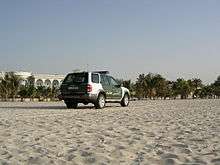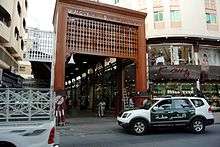Dubai Police Force
| Dubai Police Force | |
|---|---|
 The Dubai Police Force emblem | |
| Common name | Dubai Police |
| Jurisdictional structure | |
| Operations jurisdiction | Dubai |
| Size | 4,114 km2 (1,588 sq mi) |
| General nature | • Local civilian agency |
| Headquarters | Al Twar, Dubai |
|
| |
| Sworn members | 17,500 (approx) |
| Agency executive |
|
The Dubai Police Force (Arabic: القيادة العامة لشرطة دبي) is the 15,000 strong[1] police force for the city of Dubai, in the United Arab Emirates. They come under the jurisdiction of the ruler of Dubai, and they cover an area of 4,114 square kilometres and a population of 2.8 million people.
History
The Dubai Police force was founded on 1 June 1956 in Naif (a locality in the Deira side of Dubai, with the first police station being known as 'Naif Fort'[2]) with only 29 members. The size of the force increased gradually, to 105 in 1960 and to 430 by 1967.[3] In 1973, the force moved its headquarters to their current location of Al-Towar, on Al-Etihad Street in Dubai. At present, a further move is being planned to a newly constructed headquarters, again in Deira.
The Dubai Police force strives to be 'most progressive' of all Arabic police forces[3] and aims for high education standards amongst its personnel. The force was the first to use many new law enforcement techniques, including electronic finger printing and DNA testing. The force was also the first to use GPS systems to locate stolen vehicles. The force has announced that it plans to deploy its first robot police officer by May 2017, and that their ambition is to have 25 percent of the force consist of robotic officers by 2030, as well as to operate a "smart" police station that "won't require human employees".[4][5] In addition, the force was the first to create a Human Rights Department, as well as the first to employ a Community Policing programme.[3]
The new headquarters for the Dubai police is planned to be constructed in Deira, the premises were designed with several considerations in mind. As well as making easy access for both officers and members of the public a priority, the new design aims to separate the departments into different areas. The building is also to feature a central, multi-level internal space, and is designed to fit in with the developing architecture of surrounding Dubai, the Dubai police force describe it as a 'distinguished constructional conception'.
The police force closely cooperates with Civil Defence and Ambulance personnel.
After many years, the logo/emblem of the police force was modified in January 2018. [6]
Departments
The Dubai police force operates under a General Commander and his deputy, who in turn work under the Police Chief and his own deputy. The General Commander forms part of an organisational office which, with a Decision Making Support Centre, organises fifteen separate departments:
The General Department of Operations
This is the heart of the Dubai Police force. Round the clock telephone lines help to electronically control all patrols from this department, with 2,000 land lines and 178 fax machines,[7] and utilising wireless equipment to locate both car and foot patrols. The department also coordinates all emergency responses as well as search and rescue operations on land and sea.
The General Department of Artificial Intelligence
This department is another integral part of the police force, as well as being the most recent department to be created. It was established in 2001 as part of the aims of Sheikh Mohammed Bin Rashid Al-Maktoum, Prime Minister of the United Arab Emirates, to form a totally electronic government. In 2008 30% of UAE national are assigned to the work in the E-services Department to fulfill their duty. In 2014, Director-General Khalid Nasser Alrazooqi introduced Google Glass to the police force to issue fines and identify wanted cars.[8]. In 2018, the department was renamed to correspond to the new government direction towards artificial intelligence.
The General Department of Criminal Investigation
This the primary crime fighting department of the Dubai Police, its objectives are laid out by as follows:
1. Dealing with daily, small-time crimes (quarrels, swearing, defamation.. etc.).
2. Dealing with crimes of a dangerous nature, such as murder, rape, armed robbery, kidnapping, etc.
3. Dealing with organised crime (drug trafficking, money laundering, internationally wanted criminals etc.).
4. Social services, such as lost property, things found, certificates of good conduct, licences of all kinds etc.).
5. Employing scientific evidence (such as Forensic Medicine, fingerprints, documents, arsons, chemical analysis, firearms etc.).
6. Employing identity recognition means (such as fingerprints, the DNA, criminal records etc.).
7. Crime prevention methods (such guidance, directives, follow-up, statistical projections, periodicals etc.).
Police stations
There are currently eleven Dubai police stations in the city.
- Al-Rifaa
- This station was established in the 1970s to secure the Bur Dubai region. It has been reopened in different premises on two occasions, 1979 and 1992.
- Al-Muraqqabat
- this station was established in 1974.
- Al-Rashidiyah
- Al-Rashidiyah was created in 1976 as part of Al-Muraqqabat, however it became an independent station in 1984, and was moved to newer premises in 2000.
- Naif
- The original headquarters of the Dubai Police force, Naif Fort was constructed in 1929, and was used as a prison until the founding of the force in 1956.
- Al-Qusais
- Al-Qusais was founded in 1977 and moved to new premises in 1999.
- Hatta
- This station was established in 1974, and also moved to new premises, this time in 1976.
- Nad Al-Sheba
- This station opened in 1994 in Zabeel, though subsequently moved.
- Jebel Ali
- This station was built in 1971, and renovated in 2000.
- Ports
- Ports police station was also built in 1971, and watches over the Rashid Port.
- Bur Dubai
- This station was founded in 1979.
- Al-Barsha
- This new station opened in 2014 and covers the new developments in Al-Barsha and the surrounding locales.
Uniform, equipment and vehicles

The standard uniform of the Dubai police officer is an olive green shirt with a red band running under the left arm and looped through the left epaulette, a dark green beret with a golden badge depicting the logo of the police force, olive green trousers and black boots. Women officers generally wear a headscarf due to the fact that Islam is the official religion of the state.
Alternatively, officers wear a light brown shirt and trousers, though the rest of the uniform remains the same. High-ranking officers wear a combination cap and rank badges on the collar, together with their light brown uniform.

In Dubai, both male and female police officers carry semi-automatic handguns such as the Caracal and SIG Sauer pistols, while Special Emergency Units (SWAT) gain a varied arsenal of weapons such as the Heckler & Koch MP5 sub-machine gun, Glock 17 pistols, Ithaca 37 shotguns, M4 and Colt M16 variants, X26 tasers, flash grenades and other weapons depending on the situation encountered.
The Dubai police vehicles are painted with a white and dark green colour scheme, with all blue emergency lights. Every Dubai police vehicle has the force's website and email addresses printed on it. General duties and patrols are carried out by Chevrolet, Toyota, Mazda and Nissan vehicles. In 2013, the force saw the arrival of new eco-friendly vehicles, which are one seaters but can carry an additional passenger.[9] In addition to cars, the force also employs motorcycles, helicopters and boats.
Exotic and unusual patrol cars
The Dubai Police Force has recently acquired several luxury and high-performance vehicles, which include;
.jpg)
- Aston Martin One-77
- Audi R8
- Bentley Continental GT
- Bentley Bentayga
- BMW i8
- BMW M6 Gran Coupé
- Bugatti Veyron
- Chevrolet Camaro SS
- Chevrolet Corvette
- Dodge Viper
- Ferrari FF
- Ferrari LaFerrari
- Ford Mustang GT by Roush Racing
- Hummer H3
- Lamborghini Aventador LP 700-4
- Lexus GS
- Lexus RC F
- McLaren 650S
- McLaren MP4-12C
- Mercedes-Benz G63 AMG by Brabus
- Mercedes-Benz SL63 AMG
- Mercedes-Benz SLS AMG
- Nissan GT-R
- Porsche 918
- Porsche Panamera Turbo S
- Toyota Land Cruiser
- Lykan HyperSport
Motorcycles
All of these vehicles are used for patrolling tourist areas.[12][13][14][15][16][17]
Academy
The Dubai Police Academy was founded in 1987, and was granted autonomy from the police force as long as it retains some affiliation with Dubai Police General Headquarters. It was fully inaugurated in 1989 in the presence of Sheikh Maktoum Bin Rashid Al-Maktoum. In 1992, degrees offered by the academy were made equal to degrees from universities.
The first class was from 1987 to 1988, and consisted of 51 cadets and 30 full-time students, some of whom were existing police officers. They graduated in 1991. During the academic year of 1996-1997, students from Arabic countries such as Yemen, Oman, Lebanon and Palestinian Territories were admitted.
It offers several degrees, such as License in Law and Police sciences, Masters in law (with several concentrations), and Doctoral degree in law.
It maintains international standards of teaching and employs modern teaching methodology including e-learning and has revamped its website in September 2012 to introduce e-learning features.[18]
Museum
The Dubai Police Museum, located at Al-Mulla Plaza, opened on 19 November 1987. It comprises three exhibit halls, as well as documenting anti-drug efforts of the police force, and the force's prison systems. On 19 November 1987, the International Council of Museums placed the museum on the record of Arab Museums.[19]
Controversies
The police in Dubai has long been accused of brutality including the practice of torture leading to serious injury as well as death.[20] In 2011 British tourist Lee Bradley Brown was arrested by the Dubai police and died in prison after 6 days of custody in a controversial manner.[21][22] Police have arrested many people in recent years for posting humorous or satirical videos on the internet. Anyone posting material deemed offensive to Islam, the government or to the royal families, are subject to arrest.[23][24] Police have also been accused of using excessive force when dealing with protestors or prisoners.[25][26]
See also
References
- ↑ "A community force".
- ↑ Dubai Police Force Website retrieved on March 10, 2007
- 1 2 3 Alia Al Theeb, Staff Reporter. "History. Always one step ahead". GulfNews.
- ↑ "Real-life Robocops will soon replace human police". The Telegraph. Retrieved 2017-03-23.
- ↑ "A robot cop will soon be patrolling the streets of Dubai - What's On Dubai". What's On Dubai. 2017-03-14. Retrieved 2017-03-23.
- ↑ "Security, communication and innovation: Dubai Police unveil new logo". The National. Retrieved 2018-05-28.
- ↑ "Dubai Police Promote Community Outreach with RightFax, CallXpress and Infinite Mobile Delivery". Archived from the original on 13 March 2009.
- ↑ Noorhan Barakat (20 May 2014). "Dubai Police to use Google Glass". Gulf News. Retrieved 29 May 2015.
- ↑ System Administrator. "After super cars, Dubai Police launches eco-friendly mini car". Emirates 24-7.
- ↑ gulfnews.com
- ↑ phoneworld.com.pk
- ↑ "On Ferrari patrol with the Dubai police". BBC News.
- ↑ "Totalcar Magazine - Features - How to keep the roads safe with an Aston Martin One-77".
- ↑ "Dubai police get a Brabus G63 AMG". Top Gear.
- ↑ Brad Anderson. "Dubai Police Add Audi R8, Nissan GT-R and Mercedes SL 63 AMG to Police Fleet". GTspirit.
- ↑ "Watch The Dubai Police Fleet of Supercars In Action - Boldride.com". News.boldride.com. 2015-02-11. Retrieved 2016-04-21.
- ↑ Dubai FAQs. "Dubai Police Cars".
- ↑ Bassma Al Jandaly, Senior Reporter. "Dubai Police Academy marks silver jubilee". GulfNews.
- ↑ Bassma Al Jandaly, Senior Reporter. "Dubai Police: Keeping one step ahead, always". GulfNews.
- ↑ Justin Penrose (3 August 2013). "Dubai hell: Tortured and thrown in jail for a year for a crime they did not commit - Mirror Online". mirror.
- ↑ Kunal Dutta (29 April 2013). "Fresh doubts over Briton Lee Bradley Brown's death in Dubai". The Independent.
- ↑ "British tourist Lee Bradley Brown 'beaten to death' in Dubai police cell". Mail Online. 13 April 2011.
- ↑ "The Mercenary University".
- ↑ "Senior UAE official arrested over driver attack".
- ↑ "theguardian.com".
- ↑ Kaminer, Ariel; O’driscoll, Sean (18 May 2014). "Workers at N.Y.U.'s Abu Dhabi Site Faced Harsh Conditions" – via NYTimes.com.
External links
| Wikimedia Commons has media related to Dubai Police. |